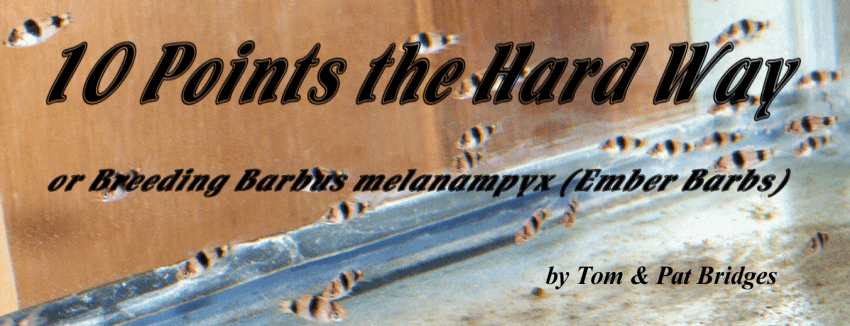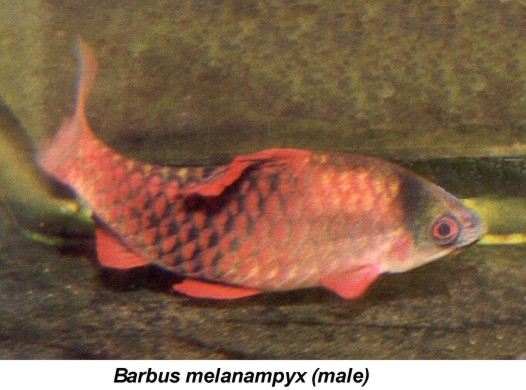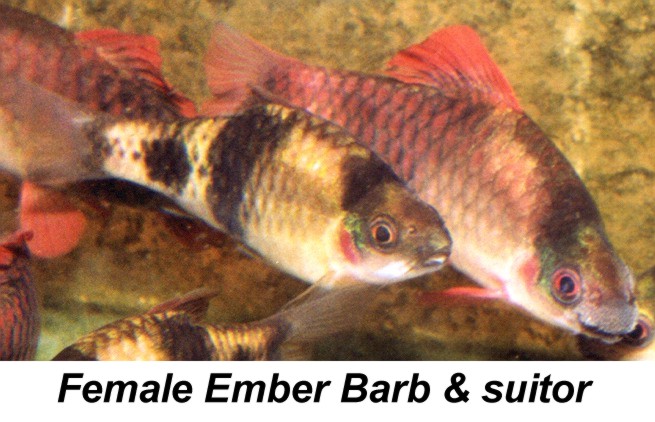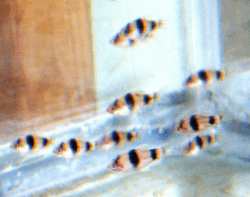
 We first became aware of these remarkably beautiful animals when Paul McFarlane surprised us by joining the unofficial 'Barb of the Month Club'. He wrote an excellent Breeder's Report called "A Winter's Barb" and published it in the Hamilton and District Newsletter. It was reprinted in the Feb. 1996 edition of our own Scat and, a bit later on, Paul generously gave us a bag full of young, healthy Embers for our very own.
We first became aware of these remarkably beautiful animals when Paul McFarlane surprised us by joining the unofficial 'Barb of the Month Club'. He wrote an excellent Breeder's Report called "A Winter's Barb" and published it in the Hamilton and District Newsletter. It was reprinted in the Feb. 1996 edition of our own Scat and, a bit later on, Paul generously gave us a bag full of young, healthy Embers for our very own.
Our problems with breeding Barbs are pretty well known within CAOAC so, although we intended to try to breed them right away, it got put off and put off. In the meantime they made themselves at home in a 15 gallon tank and schooled and ate and the males began more and more to resemble their common name.
Before I get carried away and forget, the '10 Points' in the title refers to the fact that almost all barbs are awarded 10 points in our BAP. The reason for that is a mystery to me because some barbs are extremely easy, (even for us), to breed and some are very, very difficult. You may judge for yourself how we fared with this one.
Our male Embers are about 2 1/2 inches long and the females slightly less. The females' bodies have a partial vertical black bar just behind the head, a fairly wide, complete vertical bar which starts about mid dorsal, a black spot on the caudal peduncle and a narrow black band where the tail begins. Otherwise the females are a light brownish colour and have clear fins.
The male fish obviously inspired the common name. When they are chasing the females and each other about, their fins exhibit a brilliant red colour and there bodies take on such a deep red glow that the black stripes which they share with the females nearly disappear. That large vertical band in mid body becomes a pattern of red scales with black bases.
If someone figures out how to keep them from becoming frightened and washing out during a fish show, they should easily catch the eye of the judge. They tend to be a bit shy when you approach their tank and proved difficult to photograph.
In one corner of our fish room we have our 'Barb of the Month' breeding setup. It consists of a 15 gallon tank with undergravel filtration, a plastic lid and a fluorescent canopy that has been converted to come on and go off with a timer. The back and ends of the tank have been covered with paper to provide a sense of security for the breeders. A strip of latch-hooking mesh is spread over the gravel to make finding and eating stray eggs a little more difficult and a number of bottom spawning mops are ready to be placed in mid-tank when needed.
 The water in that set up is usually varied according to the preferences of the 'barbs' to be bred. In this case we tried for softened, slightly acid water at about 80° F.
The water in that set up is usually varied according to the preferences of the 'barbs' to be bred. In this case we tried for softened, slightly acid water at about 80° F.
I placed the mops and then a trio, (1 male and 2 females), in the breeding tank just at lights out and left them until about noon the next day. They hid every time I went anywhere near the tank but, from the movement of the mop strands, I surmised that some breeding activity was going on. That attempt resulted in 5 healthy fry that survived and went to the club auction and a number of sickly babies that were never able to swim properly and became food for other fish.
This time I put just a pair in the breeding setup and forgot about them for the next two days. I saw no eggs whatever but, about 5 days later I noted several slender little guys swimming about near the bottom mesh. We fed paramecium and liquid-fry food very sparingly but frequently for the next few days and, when I took the mops and mesh out the numbers seemed to have increased.  They soon took brine shrimp nauplii and developed the beginnings of their stripes. When I removed them to their own tank in the furnace room I found that we had 43 healthy fry and no non-swimmers. They are growing rapidly on a diet of powdered flakes, some live baby brine shrimp and a treat of frozen daphnia once in awhile.
They soon took brine shrimp nauplii and developed the beginnings of their stripes. When I removed them to their own tank in the furnace room I found that we had 43 healthy fry and no non-swimmers. They are growing rapidly on a diet of powdered flakes, some live baby brine shrimp and a treat of frozen daphnia once in awhile.
This just happened recently and the only real difference in method was that I couldn't use softened water because our RO unit is dying. I forgot them for about two and a half days this time and when I removed them there appeared to be no eggs at all in the mops. I think the only eggs we get to hatch are the ones that escape attention by dropping through the mesh into the gravel. Five days later we had free swimming babies and, it's hard to be sure about numbers as yet, but it looks like somewhere between 2 and 3 dozen fry this time. Once again there are a number of sickly looking fry that can't swim right. I'm guessing that the less than ideal water might have been a factor in this but my science is weak. I'm afraid that I didn't really try to control for other variables.
We'll be bringing these barbs to some future auctions and would be interested in the spawning results of the buyers. Don't hesitate to write up your experiences. Your newsletter editor will appreciate you.